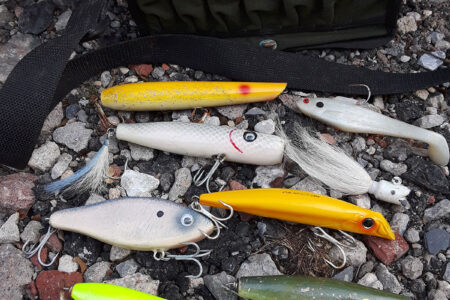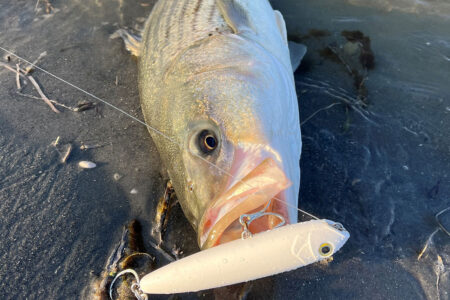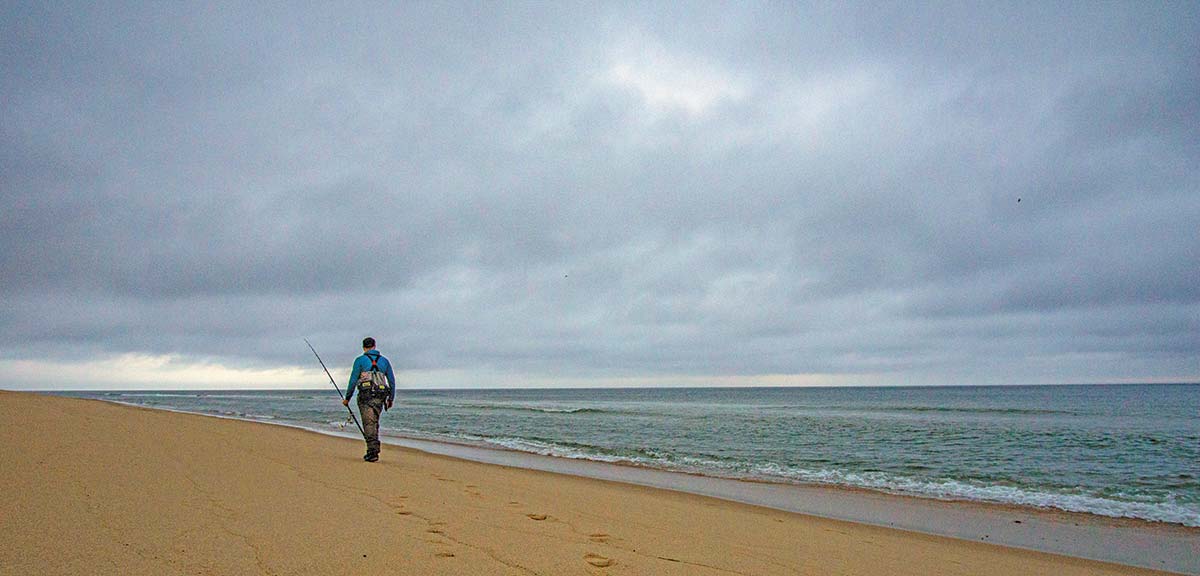
Surfcasting on open beaches sometimes means we have to dig in the sand to hook up.
I think most surf anglers go out of their way to make sure their lure never touches the bottom. This is because touching bottom often leads to hang-ups, or at minimum hooks covered with seaweed or other junk. However, on the sand beaches there is little, if any, risk of either of these things occurring. So if there is no risk, is there any reward? If you’re slinging skinny soft plastics this summer, the answer is a definitive “Yes!”
Why Drag The Bottom?
On the sand beach, there is little cover or safety for any prey item. The only place to go is out of the water (into the air or onto the beach), or down into the sand. Lots of different creatures, do in fact, dig into the sand to escape, hide, or ambush prey. The obvious and most universal example is the sand eel, which can magically dive right into the sand as if it were just a different layer of liquid and not a grainy solid. However, a variety of species of flounder do this, as do several other fish species, and lots of different crustaceans (crabs and shrimp, mostly). It’s amazing how fast and efficiently some of these animals can basically melt into the bottom. As a result, when stripers are feeding on these species, they are looking down, even rooting in the sand and having your plug not just near the bottom, but actually on the bottom, can be critical to hooking up.
That being said, don’t get too caught up in identifying the individual species, determining if stripers are feeding on them, and matching the hatch. Remember that stripers are not smart; they are evolved and conditioned. If you make your lure do a certain number of things, they will respond by eating it. The “escape into the sand” trait of many species is something the stripers are accustomed to seeing, and is a very natural presentation. Put another way, dragging bottom makes your lure look real. On nights that the fish are being fussy, or keyed in on this behavior, it can make the difference between skunking and fish every cast. The actual presentation will matter more than the color, shape, or even size of the lure. Further, unlike a magical sand eel that can quickly disappear into the sand, your lures poor ability to hide itself as it drags along attracts tons of attention, with all kinds of noise and commotion. This makes dragging bottom a valuable tool to attract fish from further away; even creating a solid bite where there originally was none.
With this logic, you might then be thinking about trying to drag all your plugs through the sand, to attract attention and induce strikes… and it can work. For example, I’ve had some success with needlefish letting them drag along for short stints. However, I find it works best with skinny soft plastics. The beauty of skinny soft-plastics is the single upward-facing jig hook and universal profile. First, the single upward facing hook helps the bait slide along naturally and fluidly, making it look more lifelike. You can get it to just glide through the sand, and not harshly dig in. Anything with a lip (like a swimmer) or treble hooks catches the bottom and jerks and stutters along strangely. It just doesn’t look as natural to me, and the almost universal lack of response from stripers makes me think they agree. Second, soft-plastics with a single hook and flexible body tend to accumulate less weed and other junk as they drag along. This means you’re not second guessing the whole time whether or not you picked up a small single strand of weed that’s fowled your offering for the rest of the retrieve. They really are perfect for this technique.
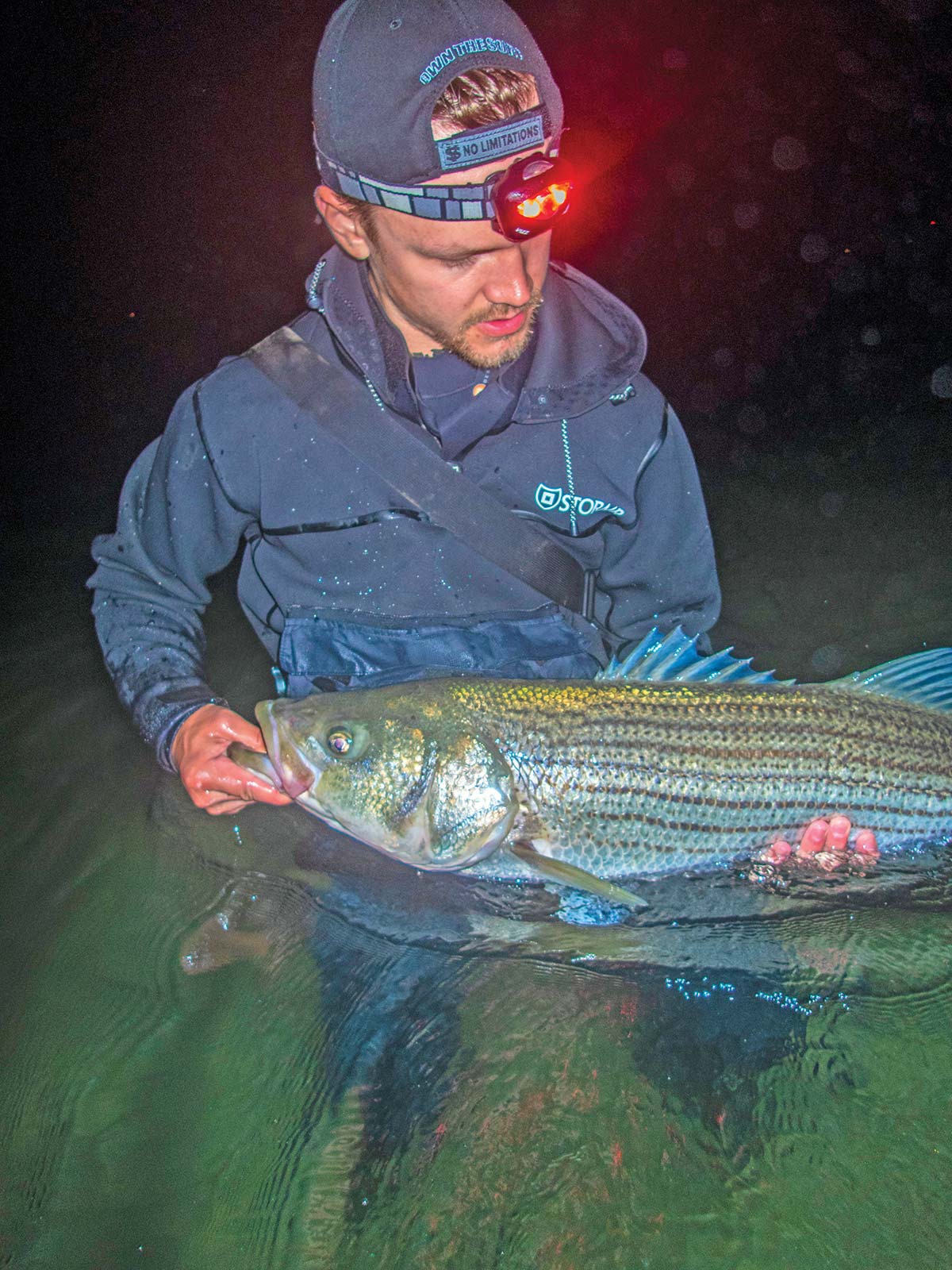
Less Is More
As with just about everything else in life, you can overdo it with the dragging technique. If you’re just touching the bottom sporadically for an instant, or “tapping bottom” as many of us call it, then I find it’s fine to let it happen a lot; pretty much the entire retrieve you can tap-tap-tap along. This can be very effective, and I think the momentary impacts lend some sporadic, life-like motion to a soft-plastic lure which can induce strikes. However, if you’re really letting your soft-plastic drag through the sand, as I’m suggesting you should try, then you have to know when you’ve gone too far. It seems every technique works at some point, somewhere, for someone, so maybe pulling a soft-plastic on a jig head through the sand from touchdown all the way back to shore works for someone; but that has never worked for me. As a general rule, I don’t like to let my lure drag more than a few seconds total every cast. It’s a spice to my presentation, not a main ingredient, if you understand my metaphor.
I think one thing anglers get wrong about dragging the plastic-plus-jig through the sand is doing it all at once. The angler will let the jig sink at some point in the retrieve, and then just drag it back for a very long time, before speeding it up and making it rise in the water column again and then just bringing it in. I think this is the wrong way to do it. Instead, I like to break up my dragging bottom into intervals, and work it into a full-column presentation. For example, I might cast-out the soft plastic, and let it start to fall, but never touch down. As I retrieve, I’ll speed it up and slow it down so it rises and falls mid-column. Then, I might stop suddenly and just let it fall straight down; this is actually one of my favorite techniques. It appears as if the prey is panicking and fleeing for the safety of the bottom. What many anglers will do then is drag it for a while, and then return it to mid-column for the rest of the retrieve. This is fine, but what I prefer is to drag it for a short period of time, bring it back mid-column, and then repeat the process over again once or twice more, dropping and dragging for short intervals. Doing this two or three times has been the most effective combination for me, and helps me blanket the bottom more effectively each cast, without dragging the entire time. Just don’t follow the exact same pattern every time, so you’re touching down at different points.
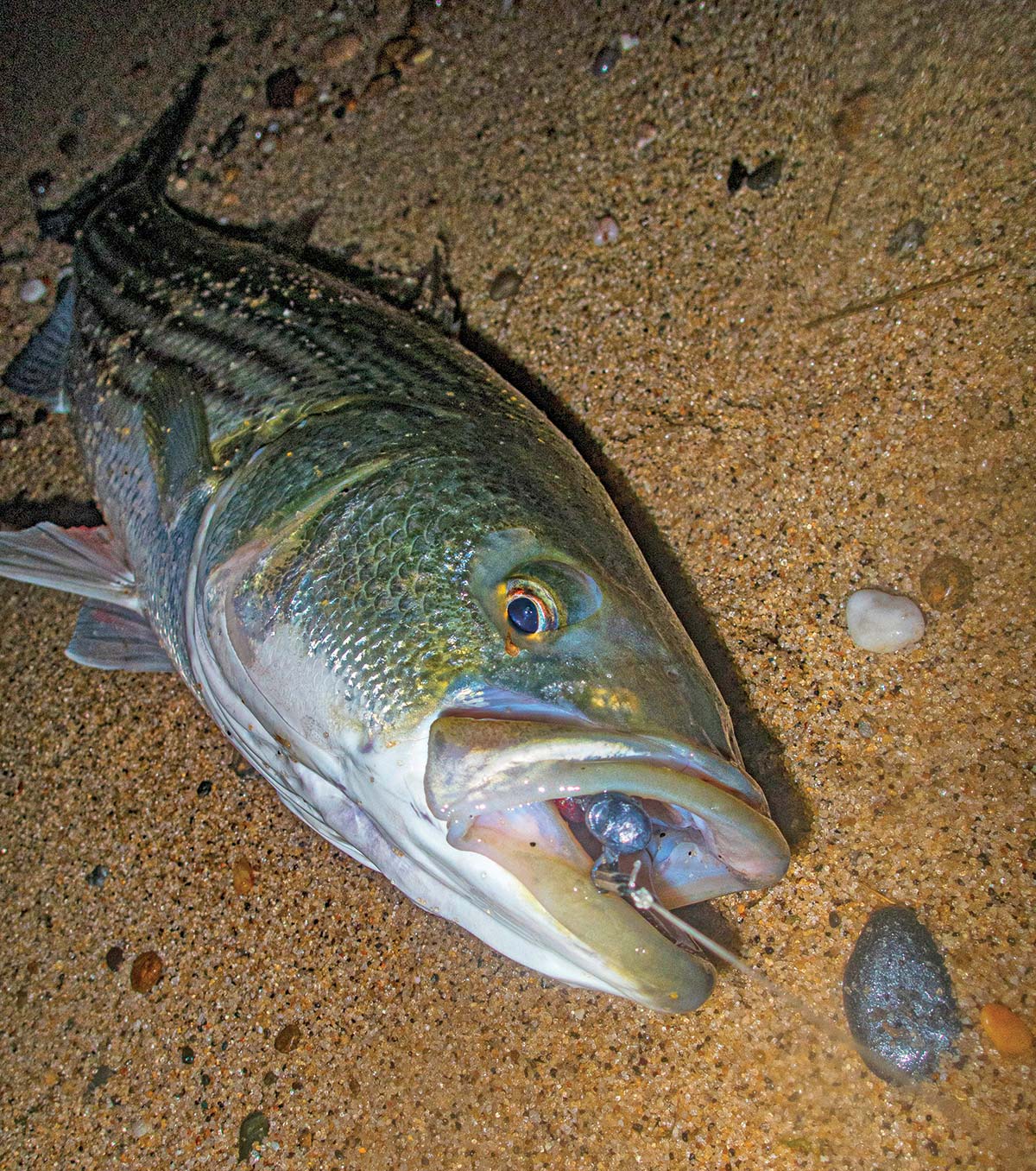
Proper Pieces
When you read the title of this article, and saw the words “drag” and “soft plastic,” you may have immediately assumed I was going to talk about heavy jigheads. I want to dissuade you from this notion. Just like with bucktails, many anglers start off much too heavy. Instead, on most beaches under normal conditions (not storms or wind events), you can accomplish the dragging technique easily with an ounce or even less. My preference on the beaches I fish is a 1/2 or 3/4 ounce. This gives me more versatility, over a heavy jig, allowing me to easily swim the lure along in 3 feet, but I can also get it on the bottom and drag it in 8 feet of water. Instead of relying on the weight of the jig, I control where the lure is with my retrieve. I can always stop or go slower, but I can only go so fast to keep a heavy jig up.
You can accomplish the dragging technique with many different kinds of soft plastics, but my strong preference is for the Lunker City Slug-Go in 7, 9, and 12 inches. The profile of the Slug-Go is big enough to attract the attention of the largest bass, but the skinny shape makes it easy to cast; a prerequisite on some of the beaches I fish. Many believe the skinny shape of the smaller sizes replicates sand eels, but I don’t think that’s as important as many others do, I’ve had the Slug-Go work wonders around bunker, squid, mullet, and when there was no visible bait at all. It’s more about the presentation, and putting it where the fish are feeding… and sometimes this means dragging it on the bottom.
For a jighead, you can use whatever brand you like best, as long as it comes with a good-sized hook and in light weights. I prefer hook sizes in the 7/0 or 8/0 range. Unlike inlet or boulder field fishing the necessity of a super thick wire and heavily-barbed hook is not as critical on the sand beach. Instead, you can back off the drag a little and let the fish run without bending the hooks. However, if you do decide to fish a thinner hook, you must set your drag properly and trust that your reel is going to perform flawlessly. I have moved away from the extra-thick tin hooks found on many jigs and bucktails, and have started using a lot more chemically-sharpened thinner hooks like those found on some of the Z-man, Owner, or MagicTail brand jigs. I haven’t pulled the hook on a big fish yet, and I feel the thinner hook means fewer dropped fish (because they penetrate so much more easily), and also do substantially less damage to smaller fish, which is important to me, too. It’s a win-win.
When stripers are grubbing for sand eels, crabs or other crustaceans, presenting your lures so that they periodically contact the bottom is often the key to hooking up. And if you’re not doing it, you’re unquestionably missing out on fish that could be caught.

